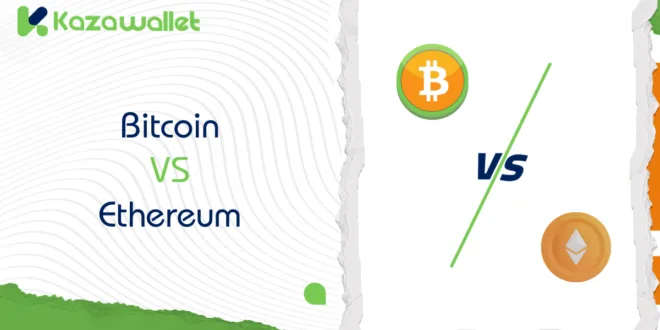While the entire world is discussing cryptocurrencies as the new economic trend, the underlying fact is the profound transformation that these technologies are introducing to the way we manage money, trust, and even economic relationships.
We have Bitcoin, the currency that started this new digitizing world and coined the word “decentralization,” on one end. And then there’s Ethereum, the platform that took this idea and created a multi-purpose, flexible system.
But beneath the hype and skyrocketing numbers, what is Bitcoin vs Ethereum? How are Bitcoin and Ethereum different? What does it mean to you? And are the two the same in use and risks? Let’s break it down.
Note: This is not investment advice. Before investing in Bitcoin and Ethereum or any other cryptocurrency, you need to do your own research and understand the associated risks.
What is Bitcoin?

Bitcoin is the first and most popular decentralized digital currency in the world, also referred to as “digital gold.” It was launched in 2009 and is completely different from traditional currencies like the dollar or euro.
The biggest distinction is that Bitcoin does not require intermediaries like governments or banks to process transactions. It relies on a secure, math-based system in the form of blockchain technology.
The key goal of Bitcoin is to provide an alternate financial system in which users can conduct financial transactions over the internet without the need for any intermediary institutions like banks or governments.
So why is Bitcoin so unique? It initiated the entire universe of digital currencies. Despite all the thousands of cryptocurrencies now in existence, Bitcoin remains the most well-known and respected.
How Does Bitcoin Work?
Bitcoin is based on a technology called blockchain, a type of encrypted digital ledger that has a record of all transactions made using Bitcoin.
Think of the blockchain as a massive ledger that records all the activity on the network, but it’s not stored in one place; it’s copied onto thousands of computers worldwide, so it’s virtually impossible for anyone to alter the data.
All transactions made with Bitcoin are recorded safely in this ledger through encryption. Since the ledger is distributed across many devices (called nodes) around the world, the devices together approve the validity of transactions.
To verify transactions and include them in the blockchain, there is a process known as mining. During this process, powerful computers are used by people called “miners” to solve difficult mathematical equations.
If a miner is the first to accurately solve the problem, a new block of transactions is added to the blockchain. Miners are compensated with new Bitcoins for their work.
Buy Bitcoin in Syria via Kazawallet: A Complete Guide
What is Ethereum?

Ethereum is a blockchain platform launched in 2015 by programmer Vitalik Buterin and his co-founders. It is a comprehensive platform that supports a wide range of applications, including smart contracts and decentralized applications (dApps).
Its digital currency is called ETH and is the “fuel” that powers the network. Whenever you make a transaction or use an application on the Ethereum network, you must make small payments in ETH. ETH is also an investment instrument, just like other cryptocurrencies.
Ethereum is similar to a decentralized internet. Instead of being operated by a single company or central entity, it’s operated and maintained by thousands of people worldwide using blockchain technology.
Here, developers and users can build and run smart contracts and decentralized apps.
How Does Ethereum Work?
Ethereum is founded on blockchain technology, the same underlying technology as Bitcoin, although with more advanced functionality. One of its most prominent features is that it supports smart contract programs that execute automatically when certain conditions are met, without intermediaries.
For example, take an online purchase. Instead of relying on an intermediary like a bank or payment processor, the trade is executed automatically once the product is received or the funds are transferred.
Unlike Bitcoin, which uses a Proof of Work (PoW) system, Ethereum has switched to another system called Proof of Stake (PoS).
In this system, some individuals known as “validators” are chosen to help validate transactions and add them to the blockchain. To become a validator, an individual must stake a set amount of ETH as collateral.
If the validator performs their work correctly, they are rewarded; otherwise, if they attempt fraud or make mistakes, they can lose their stake. Another interesting feature of Ethereum is the token burning mechanism, which reduces the total supply of ETH.
Staking 2025: Win from Staking and Increase your wallet
Bitcoin vs Ethereum: A Complete Comparison

Whereas both cryptocurrencies are built on blockchain technology, there are differences between Bitcoin and Ethereum in several aspects:
Primary Purpose
- Bitcoin: When we talk about Bitcoin vs Ethereum, we should mention that Bitcoin was created to be a decentralized digital currency and electronic payment system without intermediaries.
- Ethereum: Ethereum was designed as a platform to run smart contracts and decentralized applications, with Ether serving as the currency to support these operations.
Stability
- Bitcoin: One of the differences between Bitcoin and Ethereum is that Bitcoin is relatively more stable due to its limited supply (21 million units) and widespread adoption as a secure digital asset, though it still experiences significant volatility.
- Ethereum: Ethereum is more volatile due to its diverse use cases in decentralized applications, making it more sensitive to market changes.
Technology
- Bitcoin: When we talk about Bitcoin vs Ethereum, we should mention that it relies on relatively simple technology focused on transferring value and recording financial transactions.
- Ethereum: Uses advanced technology that supports smart contracts and complex applications.
Consensus Mechanism
- Bitcoin: When we talk about Bitcoin vs Ethereum, we should mention that it uses Proof of Work (PoW), where powerful computers solve complex mathematical problems to confirm transactions.
- Ethereum: Recently transitioned to Proof of Stake (PoS), where validators are chosen based on the amount of ETH they hold and stake.
Supply and Maximum Limit
- Bitcoin: One of the differences between Bitcoin and Ethereum is that the supply is capped at 21 million units, making it a rare asset.
- Ethereum: When we talk about Bitcoin vs Ethereum, we should mention that there is no strict cap on supply, but the issuance rate is controlled by the protocol.
Token Burning
- Bitcoin: When we talk about Bitcoin vs Ethereum, we should mention that no coins are burned in the Bitcoin network.
- Ethereum: A portion of transaction fees (Gas Fees) are burned, reducing the overall supply and improving the network’s economic health.
Transaction Fees
- Bitcoin: Transaction fees are often high, especially during periods of congestion.
- Ethereum: When we talk about Bitcoin vs Ethereum, we should mention that fees can be very high during peak times, but recent updates aim to address this issue.
Use Cases
- Bitcoin: When we talk about Bitcoin vs Ethereum, we should mention that it is primarily used as a payment method and a store of value.
- Ethereum: Used to pay transaction fees, fund smart contracts, and run decentralized applications.
Decentralization
- Bitcoin: When we talk about Bitcoin vs Ethereum, we should mention that it is considered one of the most decentralized networks due to its focus solely on financial transactions.
- Ethereum: While decentralized, the presence of applications and smart contracts makes it more complex and reliant on developer communities.
Bitcoin vs Ethereum: Risks Associated with Bitcoin and Ethereum

Risks Associated with Bitcoin
Price Volatility:
One of the most significant risks to Bitcoin is its extreme price volatility. Its price can change drastically over short periods of time, soaring one day and plummeting the next. This makes investment in Bitcoin highly risky and unstable, especially for those investors who seek assets with stable prices.
Fraud and Illegal Activities:
The market for Bitcoin is riddled with risks of fraud. The users may fall prey to frauds either from untrustworthy websites or from fake promises of acquiring digital currencies. Additionally, the lack of a central authority makes the market vulnerable to illegal activities like money laundering.
Government Regulation:
Bitcoin is in an area that is less regulated, and therefore it is susceptible to changes in government law and regulation. For instance, if a country decides to ban or restrict the use of Bitcoin, its value can drop significantly.
Technical Flaws:
Bitcoin relies on blockchain technology, which, while new, is not foolproof. The technology can be susceptible to security vulnerabilities or technical flaws that hackers can take advantage of. Moreover, the mining process that Bitcoin depends on consumes huge amounts of energy, which has environmental consequences.
Sensitivity to Political and Economic Events:
Bitcoin is highly sensitive to global events, whether political or economic. For example, economic crises or government decisions on electronic currencies can lead to drastic alteration of its value, making it less stable than traditional assets.
Security and Cyberattacks:
Bitcoins can be stolen or hacked. Once your digital wallet is hacked or you lose your private key (password), you won’t be able to retrieve your coins. Therefore, it’s essential to choose secure and reliable digital wallets, such as Kazawallet, that offer the highest protection.
Risks Associated with Ethereum
Price Volatility:
ETH is a highly volatile cryptocurrency, and its price can change by a considerable margin within a limited timeframe. With various factors such as supply and demand, technological innovation, and the general situation of the world’s economy affecting it, such volatility poses an enormous risk for investors, particularly those who desire safe investments.
Congestion and High Transaction Fees:
The Ethereum network is prone to congestion, especially during periods of high transaction activity or heavy use of decentralized applications (dApps). The congestion leads to astronomical transaction fees, making the network costly to use at times.
Updates and Technical Changes:
Ethereum undergoes periodic updates to improve performance and fix technical issues. While such updates are necessary for the development of the network, they sometimes introduce temporary problems or even security vulnerabilities if not well implemented. The transition from Proof of Work (PoW) to Proof of Stake (PoS) was a major update but raised some security and compatibility issues during the implementation.
Dependence on Decentralized Applications (dApps):
Ethereum is strongly reliant on the popularity of decentralized applications and smart contracts on the network. Should these applications fail to gain popularity or become unpopular, it could negatively impact network usage and the currency’s value.
Environmental and Energy Challenges:
Though Ethereum has moved to a Proof of Stake model to reduce energy consumption, previous accusations of its environmental impact still mar the network’s reputation. Any revival of such accusations could affect Ethereum’s global adoption.
Risks of Losing Access to Coins:
If the user loses his private key or his wallet gets destroyed, he will lose all the coins in that wallet irretrievably. There is no central authority that can recover lost coins in such cases.
In the end:
The differences between Bitcoin and Ethereum can’t be merely viewed as digital currencies or investment products, they are representative of a larger shift taking place in our financial and technological world.
It’s clear that these technologies are not the ultimate solution to all economic and monetary issues, but they are definitely a huge leap towards a new future.
But the question remains: Will these technologies remain sophisticated tools, or will they indeed revolutionize how we handle money in the coming years? And, more importantly, are you ready to be part of it?
 Blog Kazawallet
Blog Kazawallet




